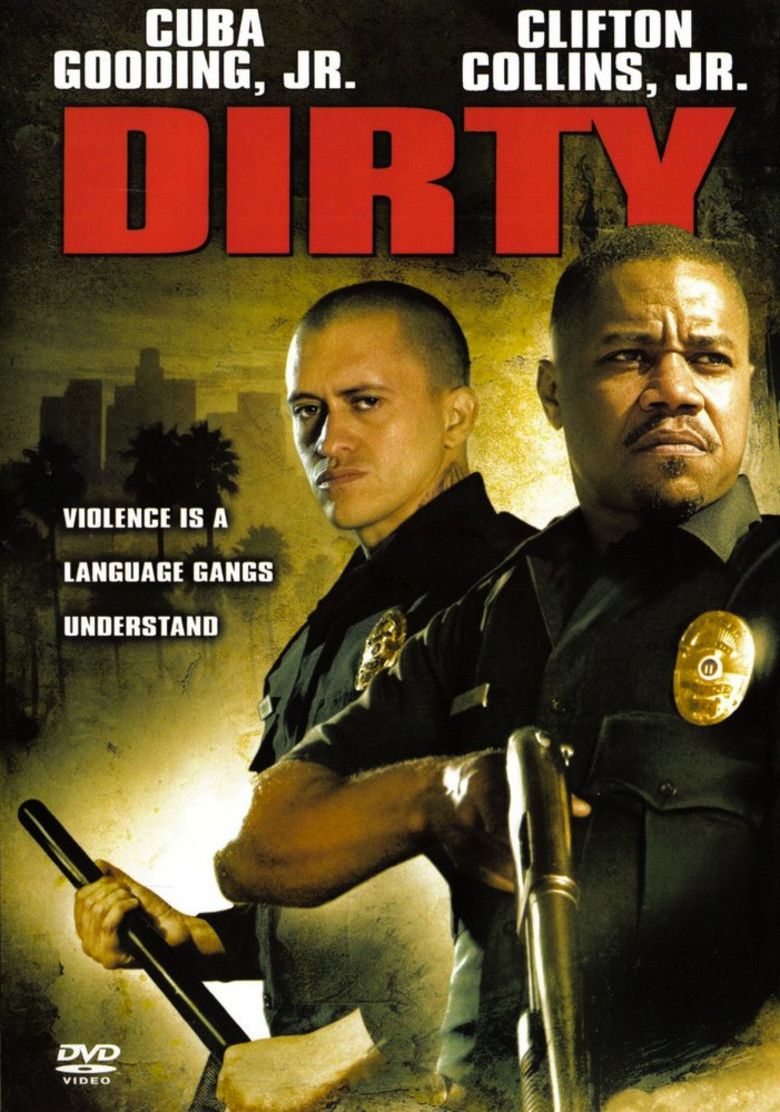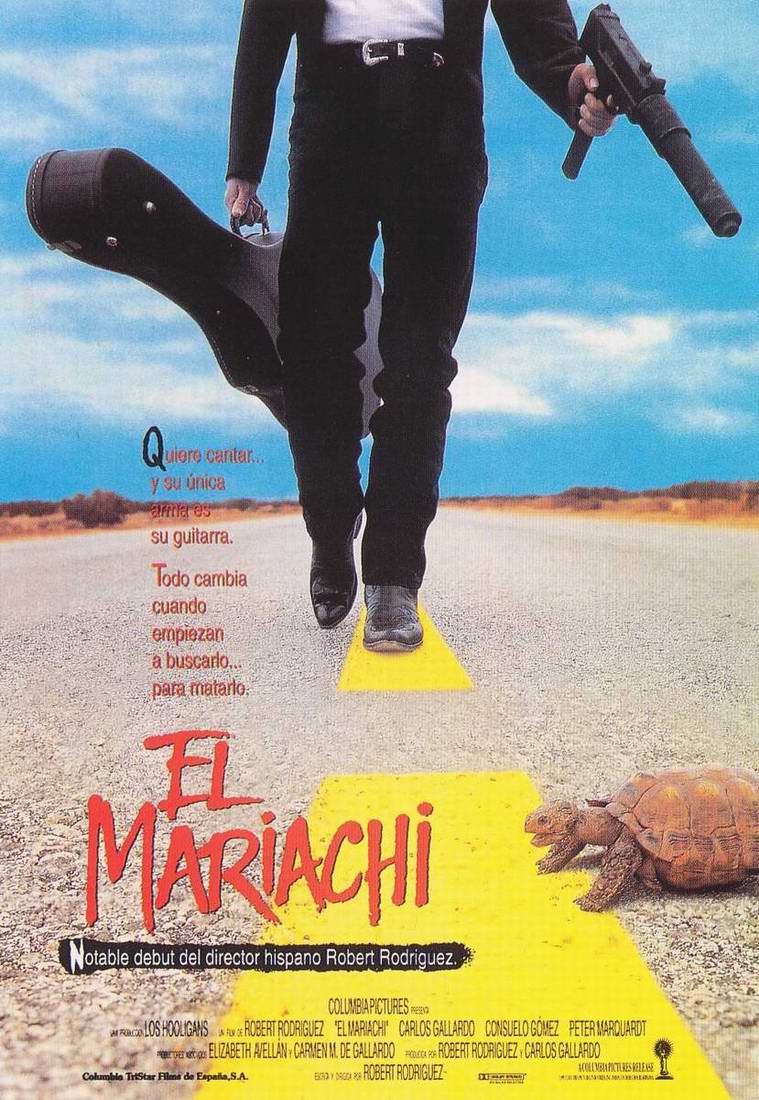Whether you're fluent in Spanish or hate reading subtitles, South of the Border has a lot to offer the discerning movie buff. Here are the best of the best:
18. 187
While Stand and Deliver is about a high school teacher who reaches his gang-banging students through education, 187's Trevor Garfield has no such luck. After recovering from a stabbing perpetrated by one of his students while at his old school in Bed-Stuy, Mr. Garfield relocates to sunny Los Angeles for a fresh start. Unfortunately for him, his new job more or less amounts to "Same sh#t, different town."
Some of his new students belong to the Chicano street gang K.O.S. (Kappin' Off Suckers) and they make it clear that he's not the one in control of the class. Having no support from the school administration, suffering from PTSD and slowly losing his grip, he takes matters into his own hands.
17. Like Water for Chocolate

Like Water for Chocolate is basically food porn. It's also a fairytale and a much more realistic Cinderella story than the one with which everybody's familiar (though there is some magic involved here too).
Tita's family tradition is that the youngest daughter is forbidden to marry so that she can serve as life-long caretaker for her mother. This also amounts to her being essentially the maid and cook for everyone at the hacienda.
Unfortunately for her (aside from being born last), she falls in love with Pedro Muzquiz and dreams about becoming his wife. Her mother, Maria Elena, thinks Pedro would make a good match for her other daughter, Rosaura.
Pedro, who is in love with Tita as well, decides that if he can't marry her, living under the same roof with her is the next best thing. And to accomplish this he agrees to marry Rosaura. The couple eventually has a baby boy, whom Tita also feeds by breastfeeding him.
Tita doesn't have three friendly witches looking out for her but she is a great cook who can influence anyone who eats her food to feel the way that she did at the time that she prepared it.
16. Soldado

15. A Walk in the Clouds
During Paul Sutton's trip home after serving in WWII and returning to the U.S., he meets Victoria Aragon, a pregnant, young Mexican-American woman returning home from college, on the bus. Although Paul is married and because he's a sucker for tears, he agrees to accompany Victoria to her family's vineyard posing as her husband because she's afraid to face her father pregnant and unwed. Gringo Paul learns about Mexican culture and sparks fly.
14. Dirty

Dirty simultaneously explores the similarities/differences between African-American and Mexican-American street gangs in Los Angeles; provides and insider's perspective on police corruption; and examines the potential divided loyalties of cops with former gang ties.
13. Stand and Deliver

Stand and Deliver is based on the true story of how high school math teacher Jaime Escalante made calculus whizzes out of his "at-risk" students at East LA's Garfield High School in the 1980s. Because the students attend a poor public school in a poor neighborhood their passing scores on the AP Calculus exam are questioned. In reality, 12 of the 14 students suspected of cheating retook the test and passed again. The two who didn't retake the test decided it was unnecessary.
Stand is the rare high school movie that's actually about education.
12. Zoot Suit

1981's Zoot Suit is the film adaptation of the play of the same name that is itself loosely based on an actual 1942 murder case -- the Sleepy Lagoon trial. A group of Zoot-suiters are railroaded straight to San Quentin due to the rampant racism of 1940s Los Angeles. In reality, the convictions were eventually reversed.
11. El Mariachi

This extremely independent film with no stars and a first-time director cost $7,000 and went on to make over $2 million and spawn two sequels featuring A-listers Antonio Banderas, Salma Hayek, Enrique Iglesias and Johnny Depp.
El Mariachi is by far the best installment in what turned into the Desperado Trilogy. In fact, Desperado is more or less a big-budget (but less realistic) Hollywood remake of Mariachi.
In a case of mistaken identity, traveling guitarist is assumed to be notorious sicario Azul, who's widely known for carrying his weapons inside of a guitar case. Because Azul's former boss, drug kingpin Moco, has ordered a failed hit on him, the killer is on his way to get revenge. Unfortunately for him, Azul shows up in Moco's town looking for work -- where it's open season on guys dressed in black with guitar cases.
10. Cesar Chavez
Arizona-born Cesar Chavez was a migrant worker before becoming a labor organizer and union leader who used non-violent protests to fight for farmworkers' rights and in 1962 co-founded the national Farm Workers Association. Chavez graced the cover of Time magazine in 1969. Surprisingly, this is the first movie about his life.
9. Suicide Squad

The most powerful member of the Suicide Squad is Chato Santana, known on the street as "El Diablo". Possessing pyrokinetic abilities that allowed him to rise to the upper echelon of Chicano gang leaders in Los Angeles, he lost his temper one night and set fire to his house, which resulted in the deaths of his wife and children. Following the tragedy, he turned himself into the police and was eventually recruited to the team of supervillains, otherwise knows as Task Force X.
8. Traffic
Traffic doesn't feature any opening credits -- which I love. I don't like to be reminded of all that behind-the-scenes rigamaroll. The movie explores the War on Drugs from various perspectives, including: a Mexican cop; the new U.S. drug czar; the wife of an incarcerated drug kingpin; and two DEA agents.
7. The Mask of Zorro
If you like Batman you might like Zorro. He's the original rich-playboy-by-day-masked-vigilante-in-black-by-night. But because he lives in the 19th century, he has a horse, Toronado, instead of the Tumbler. He also has swords instead of bat-shaped ninja stars. He uses them to cut his "signature" -- the letter "Z" -- into the necks of bad guys.
In this origin story of the second Zorro, Don Diego de la Vega, the original man in black, trains his successor. De la Vega doesn't wanna give up the cause but after his last mission, his real identity was discovered and he was imprisoned for 20 years. Knowing that he can no longer be Zorro, he passes the mask down to -- a drunken bandit. But, hey, we all gotta start somewhere.
6. La Bamba
La Bamba is a biopic of teen singing sensation Ritchie Valens, who died during the same plane crash that also took the lives of fellow 1950s rockers Buddy Holly and the Big Bopper, but Ritchie's big brother, Bob, kinda steals the show. Bob also steals Ritchie's gorgeous girlfriend, Rosie, portrayed by the late, Elizabeth Pena, who died in late 2014.
Ritchie, who was 17 when he was killed, had two #1 songs 13 years before Selena was born.
The movie focuses on Valens' career; his relationship with girlfriend Donna Ludwig, who inspired his first hit song, "Donna"; and his sibling rivalry with Bob -- the result of their mother Connie's obvious favoritism toward Ritchie.
This July 24th will mark the 30th anniversary of La Bamba's release.
5. Blood In, Blood Out

There are two sides to every story and Blood In, Blood Out is the one not fully told in American Me. While American Me focuses on the eses of the Mexican Mafia, Blood sheds light on their hated rivals, Nuestra Familia. But the two movies are very similar. Each has: a whiteboy with a Chicano accent; that same whiteboy sustaining a severe leg injury; heavy focus on prison life; and a clash between rival street gangs early on.
The title refers to the notion that gang membership is a life-long commitment -- you shed blood to get in and you have to shed blood (by dying) to leave.
The movie starts with a bang in 1972 with Cruz, his step-brother Paco and their cousin Miklo in the Chicano street gang Vatos Locos. Cruz is a painter, Paco is a golden gloves champ and Miklo is the white guy whose entire identity is tied to the gang. When Paco catches up to the rival gang leader, Spider, who crippled his brother, he gives the movies best line: "Get up Chuey, get up!" He then proceeds to cut Spider's placa (tattoo) off his hand and carves the Vatos Locos initials into his chest with a butterfly knife. Damn.
The film follows their lives as Cruz becomes a heroin junkie, Miklo does hard time in San Quentin and Paco, surprisingly, becomes a police detective. Way before Benjamin Bratt was conservative homicide detective Reynaldo "Rey" Curtis on Law & Order, he was gang leader turned undercover cop Paco aka Rooster.
If finding the movie is tricky, look for it under its other, less gangster title: Bound by Honor.
4. Savages

Did you know that weed makes up 60% of the money that Mexican drug cartels take home? Savages is all about what happens when one of those cartels tries to muscle in on two white dudes' Mom & Pop business -- a corporate takeover, except gangster style. Ordinarily, a situation like that would be over in about 10 minutes but in this case one of the white guys is a Navy SEAL.
3. No Country for Old Men

After Texas-native and Vietnam veteran Llewelyn Moss discovers the aftermath of a drug deal gone wrong near the border in 1980, he does what a lotta people in his situation would do -- he grabs the $2 million in cash and hauls ass. Unfortunately for him, he didn't notice the tracking device and doesn't have much of a head-start on the guy the Mexican drug cartel that wants the money back sent to reclaim it.
Anton Chigurh, a hired killer who is great at his job, stalks Moss like a human Terminator (the first one, not the one making jokes with the little kid). At times, he uses coin tosses to decide whether or not to kill. His weapon of choice is both ingenious and unconventional -- you've probably never even seen one of these in a movie before. Meanwhile, the local sheriff, Ed Tom Bell, is tracking Chigurh, but knows he's out of his league.
No Country for Old Men was even embraced by the Hollywood establishment. It won the Best Picture Oscar at the 80th annual Academy Awards.
2. American Me
Growing up, every dude I knew had seen American Me. We all knew who Santana and Little Puppet were. And who could forget JD -- the blonde white boy who talks with a Chicano accent? What we didn't realize at the time was that American Me is really about the rise of La Eme, otherwise known as the Mexican Mafia, one of the largest and most powerful criminal organizations in the U.S. The crazy thing is that most of the gang's membership is incarcerated.
Like Menace II Society, the movie begins with the parents of the central character in order to illustrate how violence and injustice can shape individuals and entire communities. Also like Menace, American Me juxtaposes environmental influence with individual choices.
After touching on the conflicts between American sailors and the Chicano Zoot-suiters of 1940s Los Angeles, during which time main character Santana's mother is gang-raped, the movie fast-forwards 16 years to his teenage years as a member of the La Primera street gang. When Santana and friends and fellow-gang members (in the late 1950s/early 1960s when gangs rarely used firearms) Mundo and JD break into a bar in order to hide from rival gang members, JD is shot by the owner and all three are sent to Juvie. On his very first night of incarceration, Santana is raped at knife-point by another inmate and subsequently stabs him to death.
The three friends are eventually sent to Folsom State Prison where they, along with other inmates, organize the various Chicano street gangs represented in the facility into the early version of La Eme.
After his release, it becomes abundantly clear that Santana (and others like him) lacks certain social skills that most people take for granted, such as dancing and having sex with women.
Santana, who is more philosophical and introspective than his friends, eventually questions his now life-long criminal career.
American Me also explained prison politics to the masses for the first time -- especially the racial divisions. The movie's only real competition for the title of all time greatest prison drama is 2014's Starred Up.
Supposedly, director and star Edward James Olmos became a target of the Mexican Mafia following the movie's release due to some members being offended by the film's suggestion that the group murdered one of its founders (Rudolfo Cadena, the guy Santana is based on).
The Coen brothers are currently working on a remake of 1983's Scarface. Given that the main character will be an immigrant from Mexico instead of Cuba this time around, American Me might be a good blueprint for them to use.
1. Sicario
Sicario is one of the Spanish words for assassin. While Traffic presented the War on Drugs from various angles and perspectives, Sicario gives the POV of one FBI agent who gets caught up in it up to her eyeballs and may not make it back out. The movie also provides insight into the hazy legalities involved in fighting the "war".
Agree? Disagree? Feel free to let us know in the comments down below.
Recommended:

The 7 Best African-American History Movies of All Time
John's Early Review of "King Arthur: Legend of the Sword"

"Logan" is Better Than All of the Other X-Men Movies Combined

Star Wars: Battlefront II Trailer
The only movie I will comment on is, in my opinion, the best film of this genre, if not one of the best films period and that is Sicario! Excellent movie, hands down!
ReplyDelete